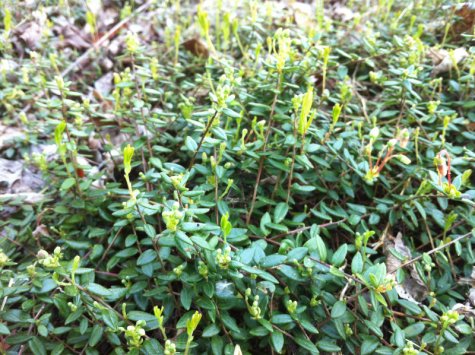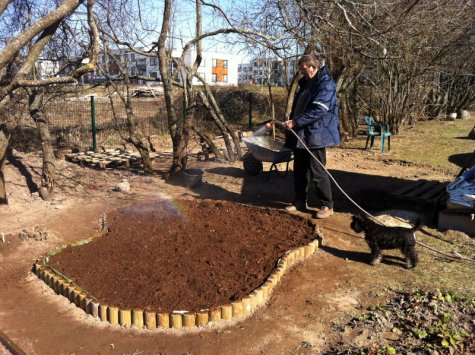A cranberry bed for your garden
Text and mobile phone photos by Kristel Vilbaste
Translation: Liis
Cranberry flower buds in the garden bed
The cold that has arrived now cuts into bone and marrow. Even a human wearing clothes has difficulties standing a temperature fall by 20 degrees in one day. Let alone our feathered friends.
For the winged ones this is the time for fledging of the chicks for those birds who spent the winter here or arrived back among the first. In the grass the fieldfare’s chicks make their flight-like jumps, the forest floor is full of them, and the ground elder leaves hang as a protective canopy above them.
At our country house the starling mum entices her chicks to get out of the nest box for the fifth day. The band of chicks is rowdy and doesn’t really fit in the box any more already since quite long but it is very nice when little maggots are delivered into your beak and so they don’t think of leaving the nest. But mum is clever and with a sound reminding of ducks’ quacking she calls them at least to the nest opening; the chicks wouldn’t come on hearing the sound if they did not know that besides this guacking there is also a beakful of delicacies. And I hope that next week they will be flying.
The first clutches of tits have fledged too, twittering is heard from here and there already, the grey babies of the nuthatches join into this children’s chorus.
The nest-dwellers, the ones still with baby feathers or plain naked, are a worry, because in such a cold they will not endure for long on their own. At the same time the parents must bring them food because without food the chicks freeze even more.
It is interesting that this year the birds have fewer young, great tits locally even half less. As if they had known that such a cold were coming.
And although mammals too should have a real baby boom now, their babies are not particularly visible. I haven’t seen rabbit kits this year nor deer fawns. Environmentalist Kaja Kübar says that the only fox pup that she has seen this year was one killed by car wheels. Kaja thinks that possibly the great heat kept the animal babies in the tall grass, and they didn’t skip around very much yet.
For bird and animal babies a threat this year has been the particularly early silage grass cutting. But the grass is truly high, while silage making generally starts when the grass has reached the height of a beer bottle then now it is already well above that. The hay mower is always accompanied by a band of white storks, buzzards, crows and gulls who kill all that managed to run from the mower’s knives.
Globeflowers end their flowering and lilies-of-the-valley are in full flower, about a week earlier than usual. The columbine shows its proud bells. In the garden the Alliums are flowering – chives, garlic and even the Welsh onion (Allium fistulosum). Strawberries are in full flower, garden strawberries as well as wild ones. Slugs are fewer this year, perhaps the January frost crept into their homes deep down. This year also promises a good cranberry harvest because the vines have plenty of flower buds and the customary period of night frosts has already passed.
Cranberry bed
I would like to write a little about cranberries this time and particularly about cranberry beds.
In gardening shops large-fruited cranberry plants have appeared for sale, at a price of 5 euro. The photos on the plant containers are beautiful, but it should be known that the large-fruited cranberry is at the northern limit of its range in Estonia and usually sunny days are not sufficiently many to make its berries tasty, or make the plant set fruit at all. And the large-fruited cranberries also tend to freeze in winters with little snow, quite as many of the southern plants that in recent years have reached our northern gardening shop chains too by way of the European plant sale channels.
But six varieties of our native cranberry might well be grown in a home garden, varieties that were developed by my parents Juta and Henn Vilbaste and which produce a winter’s store of berries from a bed of a couple of square metres. These berries are larger and tastier than the wild bog berries. And they don’t have as thick skins nor are they as woody as the berries of the large-fruited cranberry sold in the shops and imported from the Netherlands and Poland. Native cranberry varieties are Kuresoo, Nigula, Soontagana, Maima, Virusaare and Tartu. Plants can be bought from Toomas Jaadla at Marjasoo farm.
Cranberry vines, with more and larger berries, can also be sought out in a bog in autumn. A cranberry grows well already from a 15 cm long cutting.
You will get your very own and special cranberry bed.
A cranberry bed can be built as an ordinary peat bed but it must be born in mind that cranberries don’t tolerate neither total shade nor glaring sun. And they like to grow on their own in the bed, don’t put in blueberries, cranberries won’t grow in the their shade.
The cranberry bed should be dug to a depth of at least one spit (spade depth) into the soil and the bottom should be separated from the ordinary mineral soil by a polymer sheet. I set a wooden border along the edges, and added some bark mulch between the peat layers. The peat must be pressed down. It is also good to fertilize the bed a little to start with because there are not enough nutrients in the peat to start the plants growing. Because of this the bed should also be weeded in the beginning.
The most important thing is to water the bed until a permanent cover of cranberry vines has developed; later it will generally manage on its own. It may be useful to cover the bed in winter, for instance with spruce branches.
Harvesting from such a bed can start after three years, producing 6 – 20 kilos a year.
And finally an idea from my mother: if Estonia has its national flower and bird, then the cranberry might be our national berry, in our families it has always been the most valued fruit for juice and as a natural remedy.
Estonian original publ. 01.06.2014










